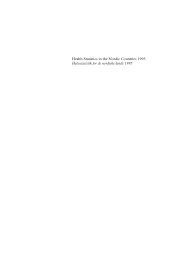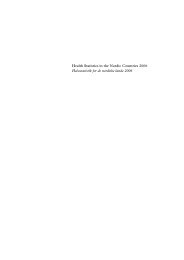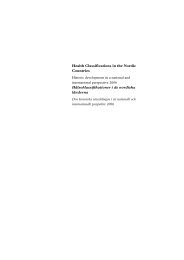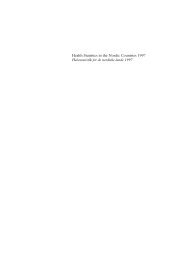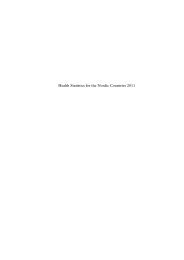Icke-inlagda patienter” - nomesco
Icke-inlagda patienter” - nomesco
Icke-inlagda patienter” - nomesco
You also want an ePaper? Increase the reach of your titles
YUMPU automatically turns print PDFs into web optimized ePapers that Google loves.
THE HEALTH OF ELDERLY PEOPLE<br />
several hours per day. The aim is that as<br />
many people as possible should be able to<br />
live in their own home. The proportion<br />
of people aged over 65/67 years who re-<br />
ceive home help services is highest in<br />
Denmark (21.7 per cent) and Iceland<br />
(21.0 per cent). The highest proportion is<br />
for people aged over 80. In Denmark half<br />
of people aged over 80 years receive<br />
home help services, according to<br />
NOSOSCO’s statistics. The statistics are<br />
not directly comparable for the different<br />
countries, because of different criteria for<br />
selection and content (see NOSOSCO’s<br />
web site). However, the statistics give an<br />
estimation of the distribution of home help<br />
services for different age groups, but not<br />
for the distribution according to gender.<br />
During the last decade, care for elderly<br />
people in the Nordic countries has undergone<br />
great changes. These services<br />
are still largely publicly financed, but dif<br />
ferent types of client contribution have<br />
been introduced in the Nordic countries,<br />
with the exception of Denmark, where<br />
the services are still free of charge.<br />
Care of the elderly in the<br />
future<br />
Because of reduced fertility, reduced<br />
mortality and increased life expectancy,<br />
the age distribution of the population in<br />
the Nordic countries has changed.<br />
The populations in the Nordic countries<br />
have become older. This means<br />
that there are fewer people of employable<br />
age to provide for more people<br />
over 65/67 years of age, depending on<br />
the pensionable age.<br />
342<br />
med detta är att så många som möjligt<br />
ska kunna bo kvar hemma. Hemhjälp<br />
är nu vanligast i Danmark och på Island<br />
med 21,7 respektive 21,0<br />
procent<br />
i åldersgruppen över 65/67 år. Det är<br />
främst i åldersgrupperna över 80 år<br />
som hemhjälp beviljats och i Danmark<br />
så får hälften av alla över 80 år hemhjälp<br />
enligt statistik från Nososko. Sta-<br />
tistiken är inte helt jämförbar mellan<br />
länderna på grund av olika kriterier för<br />
uttag och innehåll (se Nososkos webb-<br />
plats). Den ger dock en grov uppskattning<br />
av fördelningen av hemhjälp<br />
mellan olika åldersgrupper men inte<br />
hur den fördelar sig mellan könen.<br />
Äldreomsorgen i Norden har under de<br />
senaste decennierna genomgått stora<br />
förändringar. Ännu är äldreomsorgen<br />
till stor del offentligt finansierad men<br />
olika typer av avgifter har införts i de<br />
nordiska länderna förutom Danmark<br />
där den ännu är avgiftsfri.<br />
Morgondagens äldreomsorg<br />
Minskad fruktsamhet och minskad<br />
dödlighet tillsammans med en ökad<br />
livslängd har medfört att ålderssam-<br />
mansättningen i befolkningen i de<br />
nordiska länderna har förändrats.<br />
Befolkningen i de nordiska länderna<br />
blir allt äldre, vilket innebär att allt färre<br />
personer i yrkesverksam ålder skall<br />
försörja allt fler personer över 65 respektive<br />
67 år, beroende på när pensionsåldern<br />
inträder.



